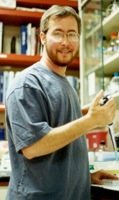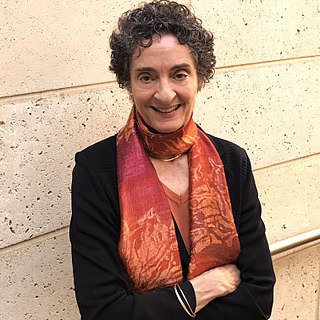Related Research Articles
The Stanford University School of Medicine is the medical school of Stanford University and is located in Stanford, California, United States. It traces its roots to the Medical Department of the University of the Pacific, founded in San Francisco in 1858. This medical institution, then called Cooper Medical College, was acquired by Stanford in 1908. The medical school moved to the Stanford campus near Palo Alto, California, in 1959.

Neurotrophins are a family of proteins that induce the survival, development, and function of neurons.

Nerve growth factor (NGF) is a neurotrophic factor and neuropeptide primarily involved in the regulation of growth, maintenance, proliferation, and survival of certain target neurons. It is perhaps the prototypical growth factor, in that it was one of the first to be described. Since it was first isolated by Nobel Laureates Rita Levi-Montalcini and Stanley Cohen in 1956, numerous biological processes involving NGF have been identified, two of them being the survival of pancreatic beta cells and the regulation of the immune system.

The p75 neurotrophin receptor (p75NTR) was first identified in 1973 as the low-affinity nerve growth factor receptor (LNGFR) before discovery that p75NTR bound other neurotrophins equally well as nerve growth factor. p75NTR is a neurotrophic factor receptor. Neurotrophic factor receptors bind Neurotrophins including Nerve growth factor, Neurotrophin-3, Brain-derived neurotrophic factor, and Neurotrophin-4. All neurotrophins bind to p75NTR. This also includes the immature pro-neurotrophin forms. Neurotrophic factor receptors, including p75NTR, are responsible for ensuring a proper density to target ratio of developing neurons, refining broader maps in development into precise connections. p75NTR is involved in pathways that promote neuronal survival and neuronal death.

Benjamin Barres was an American neurobiologist at Stanford University. His research focused on the interaction between neurons and glial cells in the nervous system. Beginning in 2008, he was chair of the Neurobiology Department at Stanford University School of Medicine. He transitioned to male in 1997, and became the first openly transgender scientist in the National Academy of Sciences in 2013. Barres is also known for his pioneering activism for equal opportunity in science, often citing his experiences as both a male and female scientist.

Carla J. Shatz is an American neurobiologist and an elected member of the American Academy of Arts and Sciences, the American Philosophical Society, the National Academy of Sciences, and the National Academy of Medicine.

George F. Koob is a Professor and former Chair of the Committee on the Neurobiology of Addictive Disorders at the Scripps Research Institute and Adjunct Professor of Psychology, Psychiatry, and Skaggs School of Pharmacy and Pharmaceutical Sciences at the University of California, San Diego. In 2014 he became the director of the National Institute on Alcohol Abuse and Alcoholism.

Theodore Holmes Bullock is one of the founding fathers of neuroethology. During a career spanning nearly seven decades, this American academic was esteemed both as a pioneering and influential neuroscientist, examining the physiology and evolution of the nervous system across organizational levels, and as a champion of the comparative approach, studying species from nearly all major animal groups—coelenterates, annelids, arthropods, echinoderms, molluscs, and chordates.
Neurotrophic factor receptors or neurotrophin receptors are a group of growth factor receptors which specifically bind to neurotrophins.
Richard Lewis Huganir is a Bloomberg Distinguished Professor in the Departments of Neuroscience and Psychological and Brain Sciences, Director of the Solomon H. Snyder Department of Neuroscience, and co-director of the Johns Hopkins Medicine Brain Science Institute at the Johns Hopkins University School of Medicine. He has joint appointments in the Department of Biological Chemistry and the Department of Pharmacology and Molecular Sciences in the Johns Hopkins School of Medicine.

Thomas Christian Südhof, ForMemRS, is a German-American biochemist known for his study of synaptic transmission. Currently, he is a professor in the school of medicine in the department of molecular and cellular physiology, and by courtesy in neurology, and in psychiatry and behavioral sciences at Stanford University.
James O. McNamara is an American neurologist and neuroscientist, known for his research of epileptogenesis, the process underlying development and progression of epilepsy. He is the Duke School of Medicine Professor of Neuroscience in the Departments of Neurobiology, Neurology, and Pharmacology and Cancer Biology at Duke University. He served as chair of the Department of Neurobiology at Duke from 2002 to 2011
Rosalind Anne Segal is an American neurobiologist. She is a Professor of Neurobiology at Harvard Medical School and the Dana Farber Cancer Institute., and the Dean for Graduate Education at Harvard Medical School Segal's work employs modern methods of cell and molecular biology to study the development of the mammalian brain with the goal of understanding how disruption of this normal process leads to the formation of brain malignancies.

Stephen George Waxman is an American neurologist and neuroscientist. He served as Chairman of the Department of Neurology at Yale School of Medicine, and Neurologist-in-Chief at Yale-New Haven Hospital from 1986 until 2009. As of 2023, he is the Bridget Flaherty Professor of Neurology, Neurobiology, and Pharmacology at Yale University. He founded the Yale University Neuroscience & Regeneration Research Center in 1988 and is its director. He previously held faculty positions at Harvard Medical School, MIT, and Stanford Medical School. He is also visiting professor at University College London. He is the editor-in-chief of The Neuroscientist.
Hans Thoenen was a Swiss neurobiologist best known for his work on neurotrophins.
Moses V. Chao is a neuroscientist and university professor at NYU Langone Health Medical Center. He studies the mechanisms of neuronal growth factor and teaches courses in cell biology, neuroscience, and physiology. He is a Fellow of the American Association for the Advancement of Science and was President of the Society for Neuroscience in 2012.
Lorne Mendell is a neurobiologist currently employed as a distinguished professor in the department of neurobiology and behavior at Stony Brook University in New York. His research focuses primarily on neurotrophins in neonatal and adult mammals, and on the neuroplasticity of the mammalian spinal cord. His research interests lie in other areas including pain, nerve wind-up, and specifically the neurotrophin NT-3. He has contributed to the growing pool of knowledge of axonal development and regeneration of immature and mature neurons. He has been a part of the search for novel treatments for spinal cord injuries and continues to study neurotrophins to determine their effects on neuronal plasticity. He served a term as president of the Society of Neuroscience during 1997–1998.
Patrizia Casaccia is an Italian neuroscientist who is the Director of the Neuroscience Initiative of the Advanced Science Research Center at the CUNY Graduate Center, as well as a Professor of Neuroscience, Genetics & Genomics, and Neurology at the Icahn School of Medicine at Mount Sinai. Casaccia is a pioneer in the study of myelin. Her research focuses on understanding the neurobiological and neuroimmune mechanisms of multiple sclerosis and to translate findings into treatments. Casaccia co-founded the Center for Glial Biology at Mount Sinai and CUNY and is one of the Directors of the center.
Bryan L. Roth is the Michael Hooker Distinguished Professor of Protein Therapeutics and Translational Proteomics, UNC School of Medicine. He is recognized for his discoveries and inventions in the general areas of molecular pharmacology, GPCR structure, and function and synthetic neurobiology. He is a member of the American Academy of Arts and Sciences (AAAS) and the National Academy of Medicine (NAM)

Nicole Schaeren-Wiemers is a Swiss neurobiologist with a focus on myelin. She is research group leader at the Department of Research (DBM) and lecturer for neurobiology at the University of Basel.
References
- 1 2 3 4 5 "Eric Shooter, founding chair of Department of Neurobiology, dies at 93". News Center. 29 March 2018. Retrieved 16 October 2018.
- 1 2 "Eric Shooter". Royal Society. 19 September 2015. Retrieved 16 October 2018.
- 1 2 "Eric Shooter - Emeritus Lecture Program". Stanford University School of Medicine. Retrieved 16 October 2018.
- ↑ "APS Member History". search.amphilsoc.org. Retrieved 11 October 2021.
- ↑ "A life in science: Eric Shooter - Office of Communications & Public Affairs - Stanford University School of Medicine". mednews.stanford.edu. 15 July 2007. Archived from the original on 15 July 2007. Retrieved 16 October 2018.